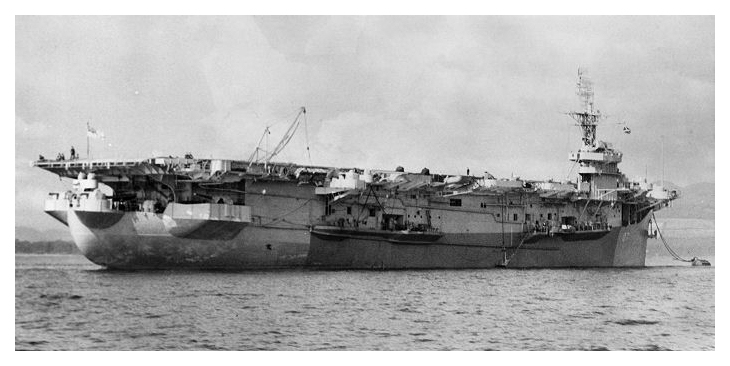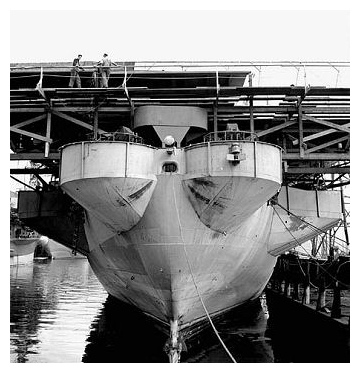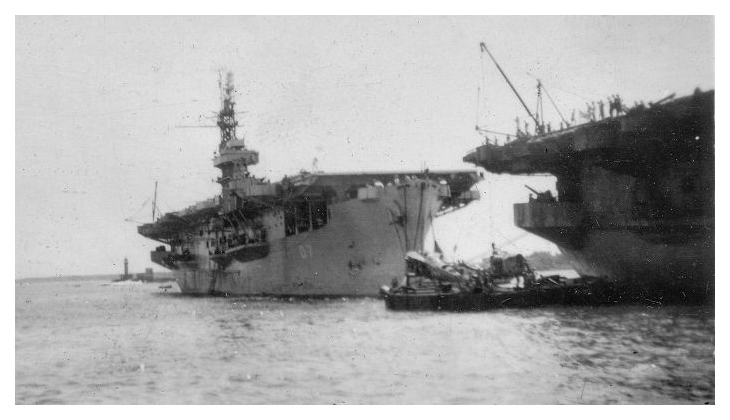A History of HMS PATROLLER
|
 |
HMS PATROLLER moored on the Clyde C.1945. Photo:
courtesy of Malcolm Rogers |
HMS
PATROLLER was an 'Ruler' class escort carrier; her keel was
laid down on November 27th 1942, at Seattle-Tacoma Shipbuilding Co.
Tacoma, Washington, as a C3-S-A1 type freighter Maritime Commission
hull number 255, Seattle-Tacoma hull number 39. The hull was
purchased by the US navy to be the USS KEWEENAW ACV-44.
Whilst still under construction it had been decided that ACV-44 was
to be transferred to the Admiralty on loan on her completion as an
aircraft carrier. ACV-44 was launched on May 6th 1943 by her sponsor
Mrs. R. G. Risley, she was transferred to the United Kingdom under
Lend Lease on June 10th 1943.Her designation was changed to CVE-44
on July 15th 1943.
On October 22nd 1943 she successfully completed her sea trials and was she delivered to the US Navy at the Seattle-Tacoma yard; she was accepted on behalf of the US Navy by Captain J. L. McGuigan, USN Supervisor of Shipbuilding at Tacoma and was transferred to the Royal Navy on the same day. She was accepted on behalf of the Admiralty by her commanding officer Captain A.J. Robertson, RNR, and commissioned into RN service as HMS PATROLLER.
Temporary allocation as Eastern Fleet Ferry carrier
It
was originally planned that PATROLLER was to proceed to
Vancouver, British Colombia, to enter Burrard's shipyard, for
modification work like her sister ships, this work was differed in
order to meet more pressing needs. Due to a shortage of merchant
shipping a shortfall in Lend-Lease aircraft deliveries from the US to
India had developed and the Admiralty proposed that three of the
newly completed CVEs should be employed in the ferry role rather
than become fully operational. Admiralty planning earmarked
EMPRESS (CVE 38), PATROLLER (CVE 44) and
RANEE
(CVE 46) for this duty,
EMPRESS was to begin ferry operations
as soon as possible, while PATROLLER would follow in November and
RANEE in December. This planning was later amended, with THANE
(CVE 48) replacing
EMPRESS; this may have been due to the
fact that
EMPRESS was fully operational upon leaving the
Seattle-Tacoma shipyard and would be required for combat operations.
In the end THANE was not required.
PATROLLER (and
RANEE) was to receive the minimum
alterations required to bring her to operational status for ferrying
purposes, and a reduced crew complement was drawn up with the air
department comprising of only an Air Engineering officer and 10
ratings - all that was required for the ferry role. The remainder of
her air department, flight deck crews etc would be drafted in when
the ship was to begin flight operations. Work on building
PATROLLER was completed on the 25th of October and she began a
short work-up program in preparation for a ferry voyage to India.
Round trip Ferry run, San Francisco to Cochin, India: December 1943 – March 1944
On completion of her work-up PATROLLER departed from Seattle on
November 22nd bound for San Francisco to load a ferry cargo of
airframes and stores; she was allocated to the Eastern Fleet as a
ferry carrier and sailed on the first leg of her voyage, to cross
the South West Pacific on December 3rd 1943. From San Francisco she
made for Melbourne. Australia, arriving there on December 22nd;
after celebrating Christmas in Melbourne she continued on to
Fremantle. Calling there on January 2nd 1944 before crossing the
Indian Ocean to dock at Cochin, S. India where her aircraft and
stores were disembarked to
RNAS Cochin on January 22nd; once unloaded she proceeded
to Colombo, Ceylon the following day. At Colombo stores and
passengers were loaded for Australia and New Zealand, before she
sailed for the return leg via Fremantle, Melbourne and Wellington
where she called on February 14th before arriving back in San
Francisco on March 7th.
Loaned to the US Army as a ferry carrier: March - April 1944
PATROLLER secured alongside Berth No.8 at US Naval Air Station Alameda on March 9th undergo voyage repairs carried out the Bethlehem Steel CO. On completion of her repairs she sailed for San Diego to embark a ferry role for the second time, this time she was on loan to the US Army to transport P.40 Warhawk airframes to bases in the South West Pacific, sailing from San Diego on March 15th. She arrived at Pearl Harbour on March 21st. After unloading she sailed on the 24th to return to Alameda for a second load. She arrived at USNAS Alameda on March 31st.
On completion of loading PATROLLER sailed from Alameda on April 6th, arriving at Pearl Harbour early on the 12th. She sailed from Pearl Harbour for Sandi ego on April 16th she called at USNAS Alameda on April 19th before sailing for Esquimalt, British Columbia on the 21st, arriving thereon the 23rd where she reverted to RN control. While at Esquimalt Captain C.D. Arbuthnot, RN relieved Captain Robertson as commanding officer.
|
 |
A US Navy band entertains crew members of HMS Patroller
on her flight deck c. April 1944. She was ferrying US
Army P.40 Warhawks. Photo: courtesy of Malcolm Rogers |
Modification and preparation to enter service: May – July 1044
On
May 1st 1944 she proceeded to Vancouver to enter the Burrard Dry
Dock Co. Ltd., North Vancouver yard and begin her delayed
modification program. PATROLLER was the eighteenth of
nineteen escort carriers to be modified by Burrards, and on arrival
at Vancouver she was secured at No 7 berth, Lapointe Pier; at this
time sister CVEs
ARBITER,
PUNCHER,
RAJAH,
REAPER,
SMITER,
THANE
and
TROUNCER were in the hands of the Burrard's yard and at
various stages of modification,. Work commenced the following day:
this work totalled 150 separate modifications and included
lengthening of the flight deck, fitting redesigned flying controls
and fighter direction layout, modifications to hangar, accommodation
and store rooms, installing extra safety measures including major
changes to the aviation fuel stowage and oiling at sea
arrangements,, modifying gunnery and other internal communications,
adding extra W/T and R/T sets, and improved darken ship
arrangements. A total of 253.5 tons of pig iron were also added
to PATROLLER for ballast.
As
work progressed PATROLLER moved through the yards various berths;
the yard could be working on six different ships at any time with
separate aspects of the work carried out at different berths, the
ships passing through like a production line, moving from one berth
to another until complete. PATROLLER moved to No 3 on May
9th, then to No 4 on May 23rd and again on June 9th to No 5 Berth.
She entered Burrard's floating dry dock on the 18th, spending five
days in dock for remedial work before returning to No 5 berth on the
June 22nd where her alterations were completed on the 28th .
PATROLLER moved to a mooring in the stream on the June 30th and
began preparing for her post modification shakedown. Her
modifications had taken a total of 55 days to complete. She also
made a round trip to the US Naval Yard at Bremerton, Washington to
ammunition the ship and then return to the Straits of Georgia
(between Vancouver Island and the mainland), for steaming, gunnery,
radar and other trials and exercises.
{Note: the last five CVEs to pass through Burrard's dockyard,
PATROLLER,
PUNCHER,
REAPER,
RANEE and
THANE had a longer
modification timetable than the other 14 vessels modified by Burrard's. This was due to the Admiralty decision that the single
Oerlikon mounts on the Gallery Deck and foc'sle deck, were to be
changed for fourteen powered twin mountings. An extra ten days was
allocated for this work to be completed.]
|
  |
Left: HMS Patroller in no.3 berth at Burrards
dockyard, Vancouver, (third week of May 1944). HMS Thane
is in the left foreground occupying no. 4 berth with HMS
Reaper can just be seen behind her in no. 5 berth. .
Right: HMS Patroller (rear left) in no.3 berth at
Burrards dockyard, Vancouver, HMS Thane is in the
foreground occupying no. 5 berth (note the twin 20mm
Oerlikon mounts fitted to the last five vessels).
Photos: Ronny Jaques / National Film Board of Canada.
Photo: Library and Archives Canada. Thanks to David
Weaver for photo interpretation. |
Ferry trip Norfolk to UK: July - September 1944
PATROLLER sailed for her maiden voyage to the UK on completion
of her post modification shakedown, and arrived at San Francisco on
July 27th on route to the Panama Canal. Once through the canal she
proceeded to the US Navy Operating Base at Norfolk, Virginia to
embark her ferry load; she arrived at Norfolk on August 10th 1944.
She was now allocated to Western Approaches Command for
ferry duties. Loading complete she sailed for New York on August
22nd to embark passengers and await an east bound convoy.
PATROLLER, in company with her sister CVE
ARBITER sailed
for the UK in convoy CU 37, departing New York on August 27th and
arriving in the UK on September 7th;
ARBITER docking at
GLASGOW and PATROLLER at Liverpool.
Ferry trip Norfolk
to UK: September - October 1944
After unloading at Gladstone Dock, Liverpool, PATROLLER made
a return crossing to Norfolk for a further ferry load, sailing form
Liverpool on September 12th with convoy UC 37. On arriving at
Norfolk on the 23rd she embarked her second ferry load for the UK.
On the 29th she sailed with convoy CU 41 bound for Liverpool; off
Ireland she broke away from the convoy and proceeded to the Clyde
estuary, arriving at Glasgow on October 9th to unload and undergo a
period of defect rectification in a Clyde yard. On leaving the
Clyde shipyard it appears that PATROLLER was used for
flying operations; possibly to test her arrestor gear and
accelerator and other Flight deck equipment. Aircraft form 768
squadron,
RNAS Abbotsinch, operated from her deck on
October 31st and November 1st -Seafire MB222 flown by Sub-Lt. LE
Garner is recorded as having gone into the barrier, tearing the
engine out of its mounting on November 1st.
Ferry trip Norfolk to UK: November - December 1944
PATROLLER sailed for Norfolk again on November 11th as part of
convoy UC 044B to collect her third ferry load, arriving at Norfolk
on November 22nd. Passengers were embarked at New York, including
evacuee children returning home to the UK. She joined convoy CU 49
off New York on December 1st 1944, and arrived in the Clyde to
unload and to receive further repair work on December 12th.
On
the completion of her repairs PATROLLER operated as a Deck
Landing Training carrier in the Clyde training areas from December
21st to the 23rd, embarking 8 Corsairs of
1843 squadron from
RNAS
Eglinton, Northern Ireland. PATROLLER was not allocated a new
role until late January 1945 when she was loaned to the US Navy.
Loan to US Navy for Pacific ferry duties: January - April 1945
PATROLLER was assigned to the US Navy from January 28th
1945, and she
sailed for the Atlantic crossing with convoy UC 54A which departed
the following day. On February 8th, a day out from New York she broke
off from convoy to rendezvous with the USS UNDERHILL which
was to escort her to the Panama Canal Zone. After safely transiting
the Canal PATROLLER arrived in San Diego on the February 25th.
She
began ferry operations with the US Pacific Fleet on March 4th,
departing San Diego on the first leg to Pearl Harbour, from there
she continued on to Guam and other forward pacific bases, unloading
passengers, stores and airframes ferried from the US and embarking
others for return to Hawaii and to San Diego. PATROLLER
completed her round trip on April 11th when she arrived back at San
Diego. She sailed for Norfolk, Virginia six days later to resume
ferry operations under the control of Western Approaches Command.
Ferry trip Norfolk to UK: May 1945
On
her arrival at Norfolk on May 1st 1945 PATROLLER began
embarking stores and equipment, in addition to a full complement of
airframes for delivery to the UK she loaded the personnel and 18
Corsair IV aircraft of
1852 Naval Air Squadron on the 4th. The
squadron had formed and worked up at
USNAS
Brunswick, Maine, on February 1st 1945 and was taking passage to
Northern Ireland to continue training in the UK. PATROLLER
sailed for New York the following day where further passengers and
stores were embarked before she joined Convoy CU 69 which sailed
from New York on May 10th, arriving at Belfast to unload on May
25th.
Refit: June - July 1945
After disembarking
1852squadron to
RNAMY Belfast PATROLLER
sailed for Liverpool on the May 26th for a refit in preparation for
operations with Rosyth Command. (It is not clear when PATROLLER
resumed operations or what duties she was employed on until she is
earmarked for conversion to a Naval Trooping Vessel in July of 1945).
Troop Ship Conversion: August - November 1945
HMS
PATROLLER was one of six RN CVEs (along with
ATHELING,
FENCER,
RAJAH,
RANEE, and
QUEEN) selected for conversion
for Naval Trooping, these ships were to be employed bringing
military personnel from the Far East back to the UK and some
commonwealth countries. PATROLLER went upstream to a Clyde
shipyard on August 15th for her conversion to a troop ship; during
this period almost all of the ship's company were drafted off the
ship and a scaled down complement arrived to man her. The carrying
capacity of a CVE with temporary accommodation added in the hangar
was approximately 60 officers and 1,000 ratings in addition to a
crew of about 250. The work consisted of converting the hangar deck
into accommodation spaces; about 600 bunks were installed along with
additional mess decks and heads. Extra fresh water storage was
achieved by converting the aviation fuel tanks, and extra storage
for food stuffs and galley capacity was installed. Additionally Corticene flooring was laid in all gangways, in all berthing spaces
and new dining hall area in the hanger. When the work was completed
in early November and PATROLLER moved downstream to a buoy
off Rosneath Patch where she was to store ship, and carry out post
conversion trials. While in the hands of the dockyard PATROLLER
received a new commanding officer, Captain J.I. Robertson RN
replaced Captain Arbuthnot on October 27th 1945.
Trooping voyages: November 1945 - November 1946
After embarking stores and some passengers PATROLLER sailed
for Devonport Dockyard where she arrived on November 13th to embark
more passengers and naval drafts (crewmen for other ships and
establishments taking passage en mass). She set out for her first
round trip trooping voyage to Colombo on November 19th, calling at
Gibraltar, Port Said and Aden on route. She arrived in Colombo on
December 15th 1945. PATROLLER remained at Colombo only long
enough to disembark her passengers store and fuel ship before
embarking personnel for the return leg to the UK; she sailed for
Devonport 6 days later. She arrived back at Devonport on January 6th
1946 having celebrated Christmas while at sea.
|

|
HMS PATROLLER at Devonport January 28th 1946. Photo:
courtesy Paul James Newton |
She
was to make three other trooping voyages to the Far East and
Australia during 1946: she sailed on her second run on January 20th
bound for Colombo and Freemantle, arriving back in the UK in mid
April. Her third run was a round trip to Sydney, departing on May
15th returning home in June. Her final round trip was to Hong Kong,
sailing from the UK on August 7th and arriving back at Devonport in
late October.
|
 |
HMS Patroller moored behind HMS Queen in Colombo harbour
March 31st 1946; Queen is embarking surplus airframes
for disposal at sea while Patroller is loading stores
and passengers ready for the next leg of her trooping
voyage. Photo: courtesy of Mrs. Kay Morgan, Thanks to
David Weaver for photo interpretation. |
Disposal: Return to
US Custody
Once all passengers had been disembarked PATROLLER began
de-storing in preparation for her return to US custody. During early
November all admiralty equipment was removed and the majority of her
ship's company were drafted to other billets, leaving a steaming
party aboard for her final Atlantic crossing. HMS PATROLLER
made her final voyage from the UK on November 27th 1946 bound for
Norfolk, Virginia via Bermuda; her passengers included GI Brides and
their children for passage to the US, and a draft of RN personnel
which disembarked at Bermuda.
She
arrived at Norfolk Naval Base, on December 9th and was
decommissioned. CVE-44 was returned to US Naval custody December
13th 1946, she was the last of the Lend-Lease carriers to be handed
back. CVE-44 was stricken for disposal on February 7th 1947 and was
sold for conversion into a merchant cargo ship on August 26th 1947.
On completion of her conversion she was operated by the United
Dutch Shipping as the S.S.
ALMKERK. She was sold in 1969 to the Thai Hwa Navigation
Corp., Panama and renamed PACIFIC ALLIANCE. She was sold for
scrap in 1974 and was broken up in Taiwan beginning in February of
that year.
|
 |
HMS PATROLLER on her return to the UK in October 1946
flying her paying off pennant with members of the crew
line the flight deck in the traditional act of 'dressing
ship' for entering harbour. Photo: Author's collection. |
Content revised:
23 June 2022
Sources used in compiling this account:
Click here for a list of
Primary sources
Additional sources:
Fold3.com various documents including;
Admiralty War Diaries
Norfolk Navy Yard War Diaries
Mew York Navy Yard War Diaries
Miscellaneous documents
|
Home
page |
go to the top
|
Comments (1)
My father served on HMS Patroller as an RP3 (RADAR) from January to November 1946.